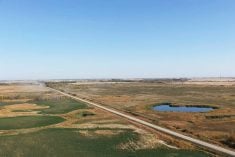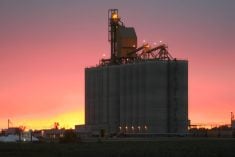A stretch of good weather has allowed most farmers in the Turtleford area to wrap up seeding, say local agronomists.
Ian Weber, sales manager with Warrington AgroDynamic, estimates 90 per cent of farmers in the Turtleford area are done, or very close to done, seeding. Farmers in the St. Walburg area, about 30 km north of Turtleford, are closing in on the end of seeding as well, he adds.
Tanner Martens, agronomist with the Turtleford and District Co-op, also thinks 80 to 90 per cent of seeding is done, other than greenfeed. Farmers with crops left in the field are also making headway.
Read Also

Claas brings 1000 Series SP forage harvesters to Canada
In mid-August, Claas unveiled its new line of Jaguar forage harvesters at an event in Visalia, California, deep in the heart of that state’s dairy region.
“It’s a struggle and an inconvenience but they’re making do with this good weather we’ve been given now,” says Martens.
Meanwhile, most farmers in the Glaslyn area are still seeding, says Dave Shepherd, location manager for AgriTeam. But Shepherd estimates close to 80 per cent of the seeding is done.
“Usually by the end of May everybody’s pretty much done except for cow-feed,” says Shepherd.
A few farmers in the Glaslyn area are still combining, but Shepherd thinks most of that will be done by Sunday, if the rain holds off.
The most recent Saskatchewan Crop Report put seeding progress at 76 per cent for the northwest, as of May 29. That’s a little behind the five-year average of 85 per cent for the region. Provincially, 81 per cent of the province’s crop is in the ground, putting it close to the five-year average of 82 per cent.
While the southern part of the province reported moisture shortages, farmers in the north-east are still struggling under extremely wet conditions. The crop report notes that 43 per cent of the crop has been seeded in the northeast, but farmers in some areas “have not turned a wheel on their equipment.” Crop reporters expect many unseeded acres in these areas.
Flea beetles ferocious
Weber says there’s “fairly heavy” flea beetle pressure. “It seems to be worse on the canola-on-canola fields, but definitely all-over.”
Flea beetles are also “ferocious” in the early-seeded canola, Weber says, possibly because crops seeded later are just starting to emerge. There’s also a lot of stem-feeding, Weber says.
“I’ve spent this whole week scouting fields for flea beetles and gotten a few guys spraying already,” Martens says. But he urges farmers to do a good field inspection before spraying.
“Guys tend to just see a few insects and get scared. But they’ve got to know what the thresholds are,” says Martens. Spraying insecticides if flea beetles aren’t near the threshold isn’t likely to benefit the crop, and will also kill beneficial insects, he explains.
CanolaWatch notes the economic threshold for flea beetles is 50 per cent leaf damage, over a wide area of the field. However, under heavy feeding, a field can go from 25 per cent to 50 per cent leaf damage very quickly. If feeding is intense, farmers and agronomists should use 25 per cent defoliation as the threshold. Stem-feeding can push that threshold below 25 per cent.
Weber and Martens note canola is still in the cotyledon to one- or two-leaf stage in the Turtleford area, leaving crops vulnerable to flea beetles. Once a plant reaches the four-leaf stage, it can outgrow flea beetle feeding, CanolaWatch notes.
Shepherd says he’s had a couple of reports of flea beetles, but nothing too serious yet. “But a lot of the canola’s just coming up now” in the Glaslyn area, he says.
Glaslyn-area farmers should be watching for flea beetles, but keep in mind they have to eat part of the plant to die (assuming the seed was treated), Shepherd says. They should also watch for cutworms, he says, as “last year there was a bit of reseeding done because of them.”
Farmers should also watch where they’re driving as they finish seeding and do other field work, Shepherd says.
“One guy told me this morning they were stuck seven times,” says Shepherd. Farmers are having problems in strange places, such as the sides of hills. And field conditions are “very deceiving,” he says, with dusty topsoil hiding very wet ground below.
Weber says that overall emergence has been excellent and he doesn’t foresee seed safety issues given the wet weather. But farmers should check emergence in fields where the canola was “mudded in.” That wet soil may have turned to concrete with recent dry weather.
“Canola may have trouble coming through.”
















